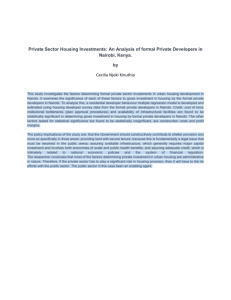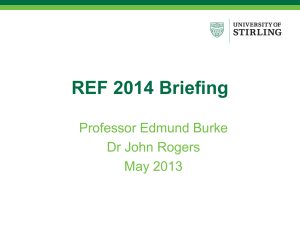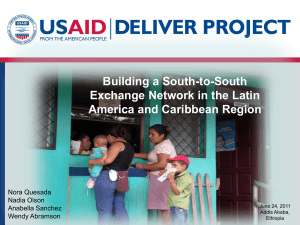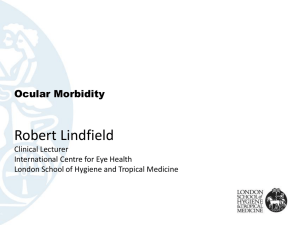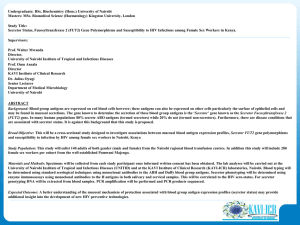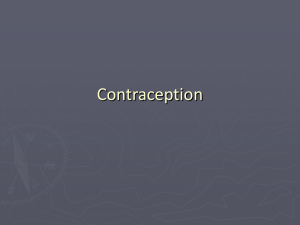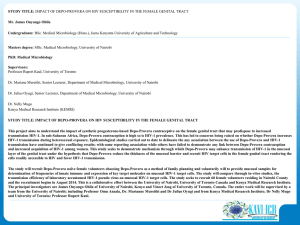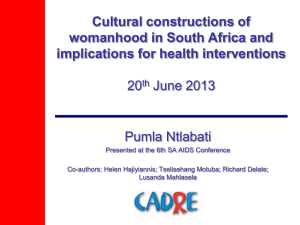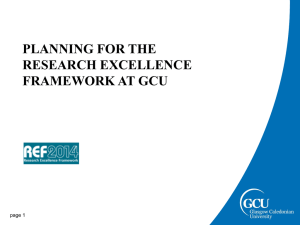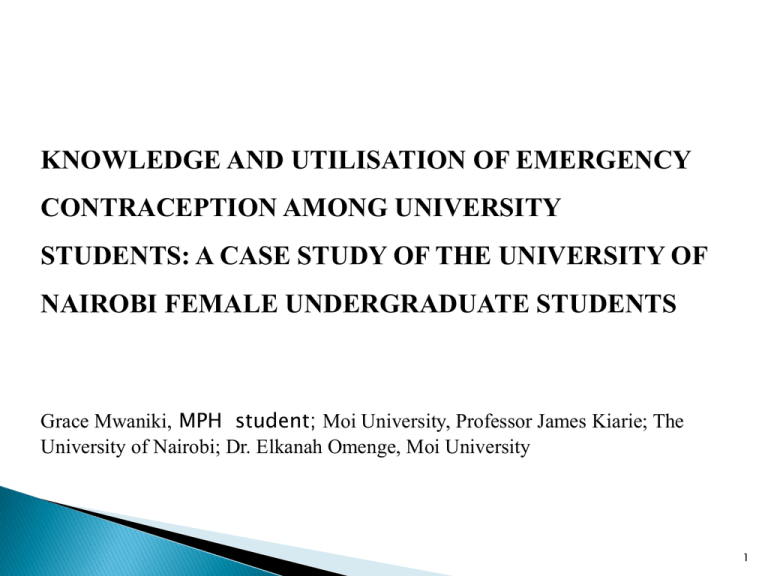
KNOWLEDGE AND UTILISATION OF EMERGENCY
CONTRACEPTION AMONG UNIVERSITY
STUDENTS: A CASE STUDY OF THE UNIVERSITY OF
NAIROBI FEMALE UNDERGRADUATE STUDENTS
Grace Mwaniki, MPH student; Moi University, Professor James Kiarie; The
University of Nairobi; Dr. Elkanah Omenge, Moi University
1
Various family planning methods have been
used to meet the dire need for control of the
high population growth (5).
Emergency contraception (EC) prevents
unwanted pregnancy after unprotected sexual
intercourse in the absence, or failure to use
regular family planning methods.
2
The rate of unwanted pregnancies in Kenya is
high at 17 percent (7).
Consequently induced abortions arise that
contribute to high maternal mortality rate in
(7).
The deficit in prevention of unwanted
pregnancies even in the existence of regular
family planning methods and availability of
emergency contraceptives is evident.
3
BROAD OBJECTIVE
To establish the knowledge and utilisation of emergency
contraceptives among female undergraduate students in the
University of Nairobi.
SPECIFIC OBJECTIVES
1) To find out the knowledge level of emergency contraceptive
among University of Nairobi female undergraduate students.
2) Establish the sources of information about emergency
contraceptive among female undergraduate students.
3) To establish practice of emergency contraception among
University of Nairobi female undergraduate students.
4) To examine the sample characteristics associated with the
knowledge and use of emergency contraceptives among
University of Nairobi female undergraduate
4
A cross sectional quantitative design among 383
female undergraduate students.
Conducted in the six colleges at University of
Nairobi using self-administered questionnaires.
Proportionate simple random sampling was used
to select the study participants.
Data was analysed using SPSS version 16.
Descriptive statistics and bivariate analysis was
used to determine significant factors associated
with knowledge and utilisation of EC.
5
CHARACTERISTIC
FREQUENCY n=383
PERCENTAGE
18-19
76
19.8
20-21
187
48.8
22
80
20.9
>22
40
10.4
MARRIED
10
2.6
SINGLE
348
90.9
COHABITING
25
6.5
CHRISTIAN
374
97.7
MUSLIM
9
2.3
AGE IN YEARS
MARITAL STATUS
RELIGION
6
CHARACTERISTICS
FREQUE
NCY
n=383
PERCEN CHARACTERISTI
TAGE % CS
FREQUEN
CY
n=383
PERCENTAGE
%
RESIDENCE
MODULE
GOVT SPONSORED
197
51.4
WITH PARENTS
24
6.3
PRVT SPONSORED
186
48.6
WITH
RELATIVES
30
7.8
IN CAMPUS
293
76.5
COLLEGE OFSTUDY
HEALTH SCIENCES
37
9.7
RENTAL HOUSE 16
(INDIVIDUAL)
4.2
HUMAN/SOCIALSCIE
NCES
199
52.0
RENTAL HOUSE 20
(SHARED)
5.2
AGRIC AND VET
20
5.2
MED INSURANCE
BIOLOGICAL/PHYSIC
AL SCIENCES
30
7.8
YES
161
42.0
EDUCATION&
71
18.5
NO
222
58
7
VARIABLE
FREQU
ENCY
%
VARIABLE
FREQUENCY
EVER HEARD OF EC
n=383
YES
331
NO
52
EC PROTECTS STI &
HIV
n=331
NO
327
YES
4
EFFECTIVENESS OF
EC
n=331
100%
197
59.5
95%
92
27.5
50%
12
3.6
%
WHEN IS EC
TAKEN
n=331
86.5
AFTER SEX
307
92.7
13.6
BEFORE SEX
9
2.7
BEFORE OR
AFTER
5
1.5
98.8
DON’T KNOW
10
3.1
1.2
KNOWLEDGE
LEVEL
n=331
HIGH ≥(70%)
141
42.6
LOW>(70%)
190
57.4
8
ATTRIBUTE
FREQUENCY
PERCENTAGE
SEXUALLY ACTIVE
n= 383
Yes
203
53
No
180
47
EVER USE OF EC
n= 203
YES
41
20.2
NO
162
79.6
YES
3
7.3
NO
38
92.7
LAST TIME OF EP USE
n=41
≤3 MONTHS AGO
11
26.8
> 3 MONTHS AGO
30
73.2
DO YOU STOCK EC FOR
FUTURE USE
9
90
80
70
PERCENTAGE
60
50
40
30
20
10
0
SOURCES
10
11
VARIABLE
FREQU
ENCY
AGE IN
YEARS
KNOWLEDGE LEVEL
LOW
n=190)
OR
95% C.I
P VALUE
HIGH
(n=140)
UPPE
R
LOWE
R
2.29 1.46
7
3.596
P<0.001
3.312
P<0.001
2.86
P<0.145
> 20
175
84 (48 %) 91(52%)
<20
156
106(67%) 50(32.1%) REF
>YEAR 2
120
55(45.8% 65(54.2%) 2.09 1.33
)
1
YEAR 1&2
211
135(64%) 76(36.0%) REF
WITH
RELATIVE
50
24(48%)
OTHERS
281
166(59%) 115(40.9
YR OFSTUDY
RESIDENCE
26(52%)
1.56 0.85
5
REF
12
VARIABLE
FRE
QUE
NCY
COLLEGE
KNOWLEDGE LEVEL
LOW
(n=190)
HIGH
(n=141)
OR
HEALTH
SCIENCE
33
10(30.3%)
23(69.7)
3.50
OTHERS
298
180(60.4%)
118(39.6%)
REF
YES
122
60(49.2%)
62(50.8%)
1.70
NO
209
130(62.2%)
79(37.8%)
REF
95% C.I
P
VALUE
UPPER
LOWER
1.612
7.637
P<0.001
1.082
2.672
P<0.021
INSURANCE
(MEDICAL)
13
VARIABLE
FREQ
UENC
Y
AGE
EVER USE
OR
95% C.I
NO(n=162)
YES(n=41)
UPPER
> 20
106
79(74.5
27(25.5%)
2.026 0.991
≤ 20
97
83(85.6%)
14(14.4%)
ref
Health
science
24
15(62.5%)
9(37.5%)
2.756 1.109
others
179
147(82.1%)
32(17.9%)
ref
HIGH
96
77(80.2%)
19(19.8%)
0.474 0.210
LOW
RESIDENCE
107
85(79.4%)
22(20.6%)
Ref
FAMILY
32
22(68.8%)
10(31.3%)
2.053 0.884
OTHERS
171
140(81.9%)
31(18.1%)
Ref
P
VALUE
LOWER
4.143
0.050
6.851
0.025
1.072
0.892
4.768
0.090
COLLEGE
KNOWLEDGE
LEVEL
14
The study revealed a high level of awareness of EC
including its limitation to protect against sexually
transmitted diseases, consistent with Kingston
Jamaican study .
Probably the higher level of learning of the study
participants exposes the students to more
information about matters appertaining to their
sexuality.
Misinformation on EC efficacy levels , appropriate
timing of taking the pill and safely repeating the EC
intake are worrying concerns that could affect the
effectiveness of the EC in preventing unwanted
pregnancy.
15
Actual EC knowledge level according to the
criterion set was low and was associated with
age, college of study and having an insurance
cover (depicts a health conscious mind-set )
Popularity of friends as a source of information
compared to health workers similar to a Nigerian
study (24),lower than Nepal (16) and South
Africa(6).
Users of EC do not store the EC pill for future
use, however there is paucity of research done
to give more information on this.
16
Despite there being high level of awareness of EC
there is low level of actual specific EC knowledge.
There is also low EC use.
Continuous public health education is needed to
improve knowledge beyond awareness on EC.
Health education about the availability of EC in public
facilities needs to be provided.
Possible use of informal sources of information such
as peer education could be an area to explore in
client education on EC knowledge and use.
17
5. Timothy, C.O., Nelson, W. and Mburu, T. K. Contraceptive Use among Women of
Reproductive Age in Kenya’s City Slums. International Journal of busisess. 2011, Vol.
2, 1.
6. Me, Hoque and Ghuman, S. Knowledge, practices and attitudes of emergency
contracetives among female students in Kwazulu, Natal, South AFrica. 2012.
7. Kichamu, G. and H., OSORO. Fertility preferences. Kenya Demorgraphic and Health
Survey 2008-2009. 2010
11. Chris, P. Adolescents and Emergency Contraceptive Pills in Developing Countries.
s.l. : Family Health International , 2005
16. Adhikari , R. . Factors affecting awareness of emergency contraceptives among
college students in Kathmandu , Nepal. Bmc Womens health. 2009.
24. Ebuehi..O.M, Ekanem.E.E. and Ebuhei T.A.O. Knowlege and Practice of emergency
contraception among female undergraduates in the University of Lagos, Nigeria. East
A frican Medical Journal. 2006, Vol. 83, 3, p. 92.
18
Institutional Ethical And Research
Committee- Moi University , for the ethical
approval.
The University Of Nairobi for allowing me to
conduct this research using it as a study area.
Moi University, School of Public Health for the
academic guidance in carrying out this
research.
19
THANK
YOU
20

